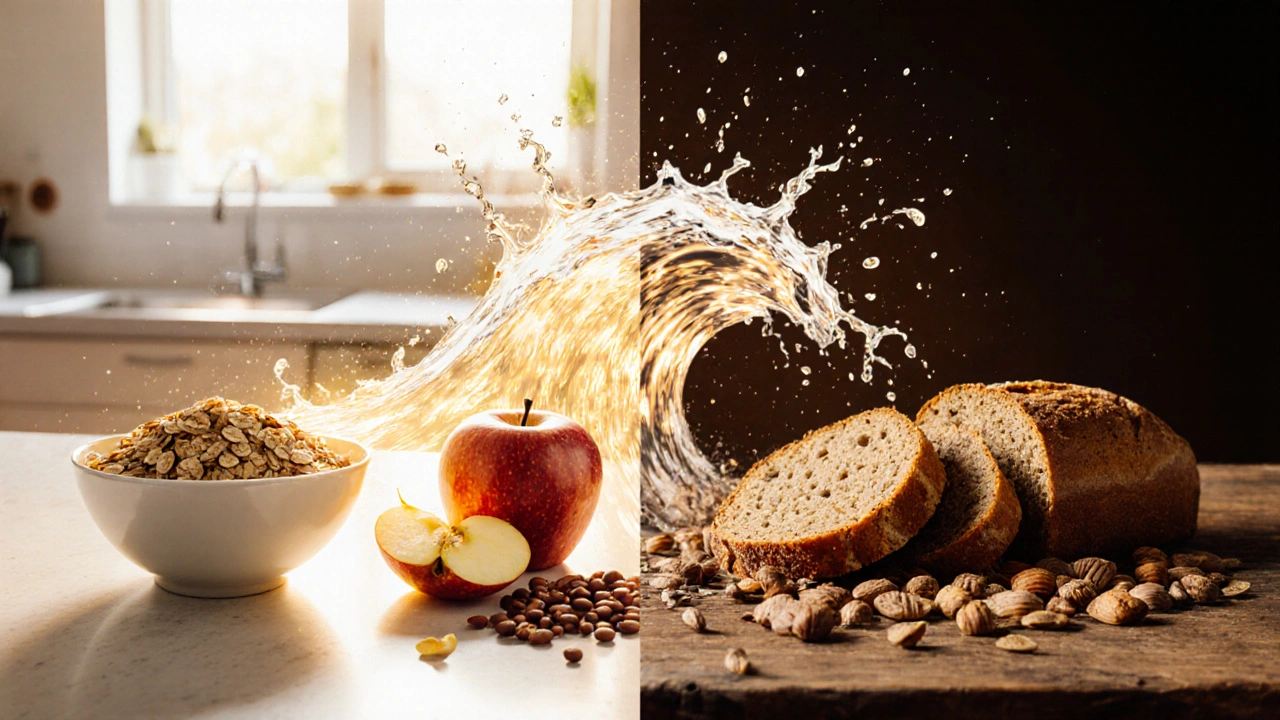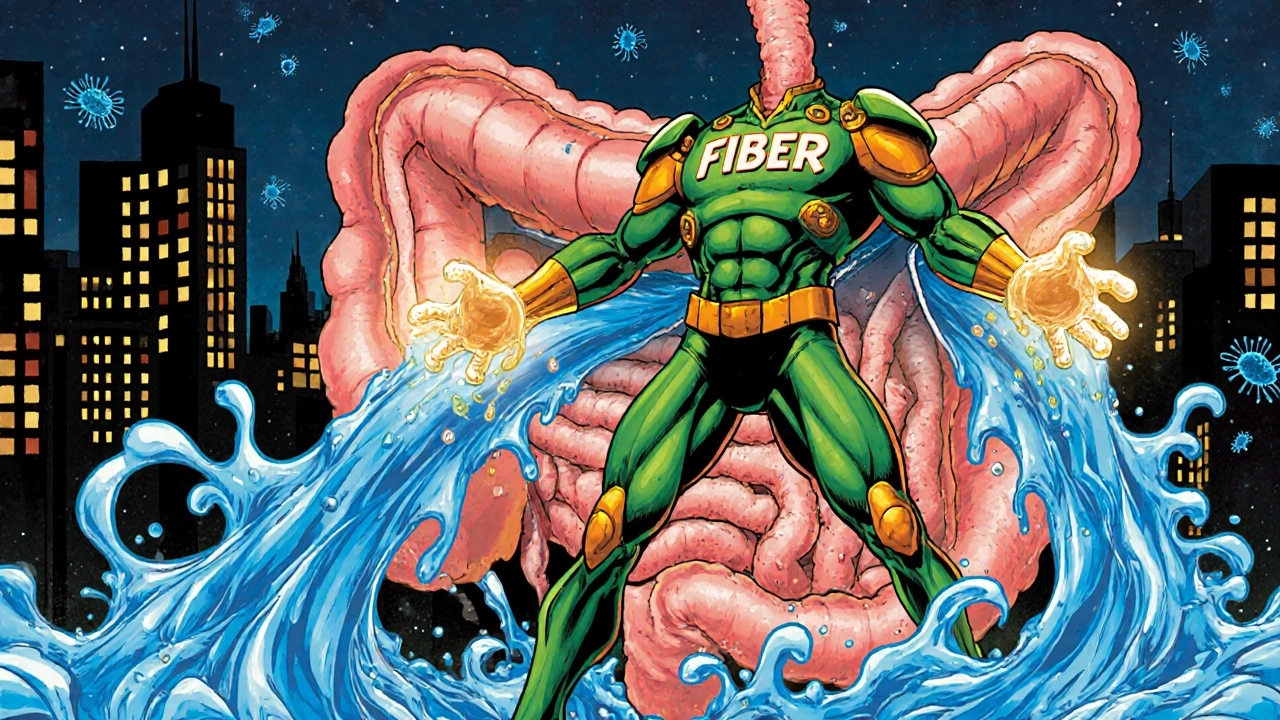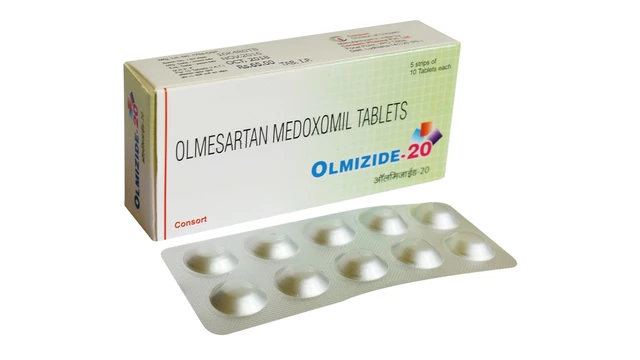Fiber Intake Calculator for Diarrhea
Personalized Fiber Plan Calculator
Calculate safe fiber intake amounts during acute diarrhea episodes based on your weight and health condition.
Your Fiber Plan
Key Takeaways
- Fiber can both slow down and bulk up watery stools, making it a useful tool for preventing and easing acute diarrhea.
- Soluble fiber absorbs water and forms a gel, while insoluble fiber adds bulk and speeds up transit.
- Eating a mix of fruits, veggies, whole grains, and legumes gives you the right balance of fiber types.
- Start with small portions and increase gradually to avoid gas or bloating.
- People with certain medical conditions should talk to a health professional before upping fiber intake.
What Is Acute Diarrhea?
Acute diarrhea is the sudden onset of three or more loose stools a day, usually lasting less than two weeks. It often follows a viral or bacterial infection, food poisoning, or a reaction to medication. The biggest worries are dehydration and electrolyte loss, especially in children and older adults.
According to the World Health Organization, acute diarrhea accounts for around 1.7 million deaths each year, most of them in low‑income countries where rehydration therapy is delayed. In more affluent regions, the condition is rarely fatal but can still knock you out of work or school for a few days.
How Fiber Works in Your Gut
Fiber is a plant‑based carbohydrate that your body can’t fully digest. Instead of disappearing, it travels through the digestive tract and interacts with water, bacteria, and the lining of the intestines. This interaction does two useful things for diarrhea:
- Water management: Soluble fiber absorbs excess water, turning a runny stool into a thicker, more manageable form.
- Bulk creation: Insoluble fiber adds physical mass, helping the colon push stool forward at a steadier pace.
Both actions reduce the frequency of watery bowel movements and give your body a chance to re‑absorb fluids and electrolytes.
Types of Fiber and Their Specific Benefits
Not all fiber behaves the same way. The two main families are soluble and insoluble, and each offers distinct advantages for acute diarrhea.
| Attribute | Soluble Fiber | Insoluble Fiber |
|---|---|---|
| Water affinity | Absorbs water, forms gel | Does not dissolve, adds bulk |
| Effect on stool | Thickens loose stool | Increases stool weight |
| Typical sources | Oats, apples, beans, psyllium | Whole wheat, nuts, seeds, skin of fruits |
| Prebiotic potential | Feeds good gut bacteria | Limited fermentability |
Soluble fiber is the type most often recommended when you’re battling diarrhea because its gel‑forming quality can quickly turn a liquid mess into something you can control. Good examples are oat bran, pectin from apples, and psyllium husk. On the other hand, Insoluble fiber is valuable for maintaining regular bowel movements once the acute phase has passed. Think of whole‑grain bread, corn bran, and the skins of potatoes.

Prebiotics, Probiotics, and the Gut Microbiota
Fiber isn’t acting alone. When you eat soluble fiber, it often acts as a Prebiotic, which means it feeds the beneficial bacteria living in your intestines. A healthier Gut microbiota can outcompete harmful pathogens, produce short‑chain fatty acids, and improve the gut barrier.
Pairing fiber with Probiotics (live microorganisms found in yogurt, kefir, or supplements) can speed up recovery. Studies from 2023 showed that a combined regimen of soluble fiber and Lactobacillus strains reduced diarrhea duration by an average of 1.2 days compared with rehydration alone.
Practical Ways to Add Fiber During an Episode
When you’re already feeling lousy, the last thing you want is a complicated diet plan. Here are some simple steps you can follow:
- Start with a low‑dose fiber drink. Mix 1 tablespoon of psyllium husk with a glass of water or clear broth. Wait 5 minutes, then sip slowly. This gives you soluble fiber without overwhelming the stomach.
- Choose easy‑to‑digest fruits. Cooked apples, ripe bananas, and canned peaches are soft, low‑fiber‑fat, and still provide pectin.
- Add a spoonful of oats. Instant oatmeal made with water (no added sugar) is a gentle source of soluble fiber.
- Stay hydrated. Every gram of fiber pulls water into the stool, so you need extra fluids. Oral rehydration salts (ORS) are the gold standard, especially for children.
- Gradually introduce insoluble fiber. Once stools are less watery, sprinkle a tablespoon of wheat bran or finely chopped raw veggies into a soup.
Remember: The goal is a balanced mix. Too much fiber too fast can cause gas, bloating, or even worsen diarrhea.
When Not to Load Up on Fiber
Fiber is a powerhouse, but it’s not a one‑size‑fits‑all solution. People with certain conditions should be cautious:
- Irritable bowel syndrome (IBS) with a diarrhoea‑predominant pattern. High‑fermentable fibers can trigger cramps.
- Severe intestinal inflammation (e.g., active Crohn’s disease). Bulk can irritate ulcerated sections.
- Recent gastrointestinal surgery. The gut needs time to heal before handling a lot of bulk.
If any of these apply, talk to a doctor or a registered dietitian before making big changes.

Putting It All Together: A Sample 24‑Hour Plan
06:30 - 1 tsp psyllium in 250ml water (wait 5min, then sip) 08:00 - Warm broth with a spoonful of instant oatmeal 10:30 - Small cup of cooked apples (no sugar) 12:00 - ORS solution (½L) + a slice of whole‑grain toast (optional) 15:00 - Banana smoothie (½ banana, 200ml water) 18:00 - Light vegetable soup with a tablespoon of wheat bran 20:00 - Herbal tea (no caffeine) and a small piece of ripe pear
This schedule gives you a steady stream of soluble and insoluble fibers, keeps fluids up, and avoids heavy meals that could worsen symptoms.
Frequently Asked Questions
Can fiber replace oral rehydration salts?
Can fiber replace oral rehydration salts?
No. Fiber helps manage stool consistency, but it doesn’t restore electrolytes. ORS is still essential, especially for children and the elderly.
How much fiber is safe during an acute episode?
Start with 3‑5g of soluble fiber per day (about one tablespoon of psyllium). Increase slowly if tolerated, but stay under 20g total until stools normalize.
Is it okay to eat bananas when I have diarrhea?
Yes. Ripe bananas provide pectin (a soluble fiber) and potassium, which helps replace lost electrolytes.
What foods should I avoid?
Steer clear of high‑fat fried foods, very spicy dishes, and large amounts of raw cruciferous veggies (like broccoli) that can cause gas.
Can fiber worsen diarrhea if I have a bacterial infection?
If the infection is severe (e.g., Clostridioides difficile), doctors may recommend a low‑residue diet temporarily. Always follow medical advice in such cases.
Bottom Line
Fiber, especially the soluble kind, is a practical ally when you’re trying to stop a sudden bout of watery stools. By absorbing extra water, feeding good bacteria, and providing gentle bulk, it helps you stay hydrated and get back to normal eating faster. Pair it with proper rehydration, start low, and listen to your body. If you have chronic gut issues or any warning signs, get professional guidance.












Tiffany Owen-Ray
16 Oct, 2025
Imagine your gut as a bustling marketplace where every bite you take becomes a traveler seeking a place to settle. When a sudden storm of watery stools hits, the market stalls are overwhelmed and chaos erupts. Fiber steps in like a seasoned organizer, gently coaxing excess water into a manageable flow and adding just enough bulk to keep the stalls from collapsing. Soluble fiber, the smooth-talking diplomat, absorbs the surge of liquid and forms a gel that turns a torrent into a steady stream, while insoluble fiber, the sturdy laborer, adds physical mass that nudges the contents forward with purpose. Together they balance the chaos, allowing the intestinal walls to re‑absorb precious fluids and electrolytes that would otherwise be lost. Think of psyllium husk as a sponge that doesn’t drown the system but instead sops up the spill, whereas a handful of oats offers a gentle scaffold for the material to pass through. By feeding the beneficial bacteria, soluble fiber also nurtures a community of microscopic allies that outcompete harmful pathogens, a subtle yet powerful reinforcement of the gut’s defenses. This microbial partnership produces short‑chain fatty acids that fortify the intestinal barrier, making it less leaky and more resilient to infection. The practical side of all this theory is simple: start with a modest dose, perhaps a teaspoon of psyllium in a glass of water, wait a moment, then sip slowly, giving your system time to adapt. Gradually increase the amount as tolerated, and intersperse with easy‑to‑digest fruits like cooked apples or ripe bananas, which contribute pectin, another form of soluble fiber. As the stools become less watery, you can introduce a teaspoon of wheat bran or finely chopped vegetables to provide the insoluble component that keeps the rhythm regular once the storm passes. Hydration remains paramount, because each gram of fiber draws water into the stool; without sufficient fluids, you risk constipation or worsening the situation. Pairing this approach with oral rehydration salts ensures that electrolytes are replenished, especially for the young and elderly who are most vulnerable. Remember, the goal is not to flood the intestine with fiber but to create a harmonious blend that restores balance, much like a conductor guiding an orchestra back to harmony after a sudden discord. In essence, fiber is a versatile tool that, when used wisely, can transform a frightening bout of diarrhea into a manageable situation, allowing your body to heal while you stay comfortably hydrated and nourished.
Jill Brock
18 Oct, 2025
If you think fiber is a miracle, you’re living in a fantasy world.
Juan Sarmiento
19 Oct, 2025
Hey folks, just wanted to say that incorporating a bit of soluble fiber like psyllium can really calm things down when you’re stuck with the runs. I’ve tried the low‑dose mix myself and it helped thicken things up without feeling bloated. Pair it with a good hydration plan-water, broth, or an ORS solution-and you’ll notice the frequency dropping. Don’t forget to add some easy fruits like cooked apples; they give you pectin, which is another gentle gel‑forming fiber. Once you’re feeling better, sprinkle in some wheat bran for that extra bulk to keep things moving smoothly.
Patrick McVicker
19 Oct, 2025
👍 Nice tips, Juan! I’d add that a quick oat water brew works like a charm too. 🍚
Liliana Phera
21 Oct, 2025
Listen up, the gut isn’t just a passive tube; it’s an ecosystem that reacts aggressively when you flood it with the wrong kind of fiber. While soluble fibers can be a balm, loading up on insoluble too early can exacerbate cramping, especially if you have an underlying IBS‑D profile. The key is to gauge your body’s feedback – any sharp pain means you’re pushing the limits. Also, remember that some “healthy” foods like raw cruciferous veggies can ferment excessively and produce gas, worsening the discomfort. If you’re on antibiotics or battling a bacterial infection, temper your fiber intake and follow a low‑residue diet to avoid feeding the bad bugs. In the end, moderation and timing are your allies; treat fiber as a strategic supplement, not a blanket cure. Don’t ignore professional advice if symptoms persist beyond a couple of days; the gut can be deceptive and hide deeper issues. Lastly, keep your electrolytes topped up – fiber alone won’t replace the salts you lose.
Poorni Joth
22 Oct, 2025
i think its imortant to not overdo fibre especially when you r sicken its easy to think more is better but you can get bloated and more diarrhee if you push it too fast also watch out for people with crohn's or other inflammed gut dont just jump on the high fibre diet their condition might not handle it well. and if your taking meds its always good to talk to a doc first.
Yareli Gonzalez
24 Oct, 2025
Great rundown-starting slow and listening to how your body feels is definitely the safest route.
Alisa Hayes
26 Oct, 2025
Just a heads‑up: be mindful of the sugar content in flavored oatmeal packets; they can actually draw more water into the gut and counteract the benefits of fiber. Stick to plain versions and add a splash of fruit if you need flavor.
Mariana L Figueroa
27 Oct, 2025
Fiber works best when paired with proper rehydration – water, ORS, or clear broths are essential.
Diane Helene Lalande
29 Oct, 2025
Overall, a balanced approach-soluble first, then insoluble, plus plenty of fluids-helps the body recover without unnecessary discomfort.